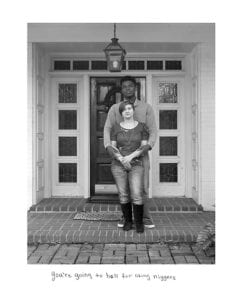
db: So, tell me about who you are & where you’re from. Do you have cats or dogs or kids running around? Do you hike on weekends? Do you live the life of the quintessential southern college professor?
DP: I have a great job as a college professor and I’m blessed with peers who support me. I love my job, and I love having summers free to photograph my personal work and to be with my daughter Austin. I also enjoy biking, going fishing as well as visiting my family on Cane River in Louisiana. I’m able to fish, and most times, feed my family a dinner with crappie, bream and catfish. We call it “Living off the land!”
And dogs -most definitely dogs! I grew up with every animal you could think of. My mother was open to not only the normal pets like cats and dogs, but also hamsters, fish, parakeets and mice. We even had a pet cemetery. I now have a golden retriever and a labradoodle, too.
db: You’ve got family in Louisiana. Tell me a little about growing up there & how photography entered your life.
DP: I grew up in Alexandria, Louisiana with one sister and two brothers. My parents divorced when I was about eight. My mother brought me up to be an independent person. She instilled in me the ability to take care of myself, be independent, self-sufficient, and for that I’m grateful. Catholicism was very important to my mother, and because of that, I attended Catholic schools from kindergarten through high school.
One of my fellow classmates in high school had a camera and he was photographing with black and white film. I was immediately intrigued with the photographic process, so much so, that I went to the bank and took out a loan to buy a Fujica ST605: my first camera. Not long after that I learned how to process black and white film and haven’t stopped since.
After high school, I studied photography and received a Bachelor of Fine Arts in Photography from Louisiana Tech University. With only two photography professors, I was able to take a variety of other creative classes that included independent study, portraiture, studio lighting, and product photography. This block of time gave me the chance to discover that portraiture was the area I wanted to pursue.
By developing an area of concentration, I was able to build the start of a strong portfolio. This laid the groundwork for a paid internship before and during the 1984 New Orleans World’s Fair. The internship provided diverse opportunities, from architectural documentation to press conferences with performers. It also afforded me plenty of exposure to people of different cultures from all over the world.
After undergraduate school, I moved back to New Orleans to work for a commercial photography studio and to freelance, and was soon accepted to graduate school at the University of Texas at Austin where I pursued a Master of Fine Arts degree with an emphasis in photography. While there I experimented briefly with landscape photography and was highly inspired by the quality of natural, ambient light. This stimulated my interest in photographing people outdoors, in an environment of their choosing- the environmental portrait, if you will.
db: So you’re from Louisiana, did some schooling in Texas, & now you’re in Arkansas. How would you say that life in these southern states has influenced your work?
DP: That is hard to answer since I have only lived in the South. I will say that I don’t like cold weather and I like to photograph people with available light. I think that can be more conducive to the type of photography I like to do.
db: Tell me about your project, “Southern Depictions.”
DP: In 1991, I moved to Little Rock, Arkansas to teach photography at the University of Arkansas at Little Rock. This is where I began my second major project titled: Southern Depictions. I concentrated only on photographing the neighbors within walking distance of my house. To my surprise, most parents were hesitant to be photographed but were willing to let me work with their children. I wanted to create an honest portrayal of each child at that moment in their lives. Environmental context was a primary element in staging these narratives. The children chose the location, the outfit, & the objects they were to be photographed with.
I began by working with one child at a time, but as my subjects have grown and matured, people and relationships have replaced toys and skateboards both in their lives and in my photographs. Siblings and friends, casual acquaintances, and most recently, romantic partners have become part of the “environment” that needed to be captured.
db: You’ve received a couple of fellowships, haven’t you?
DP: Yes. Between 1994-95, I received a Visual Arts Fellowship from the Arkansas Arts Council and another Visual Arts Fellowship from the Mid-America Arts Alliance. These fellowships allowed me to continue photographing and to print more of my work in the darkroom. I continued to photograph children over a number of years. It was a true gift to watch as they passed through adolescence into young adulthood before my eyes and in front of my camera. My goal throughout that project has been to portray not how the world sees them, but how they see themselves.
db: Your project “Sticks & Stones” has gotten a lot of press… Slate, Huffington Post, MTV & more. Congratulations! Tell me about this project… when did it start?
DP: The “Sticks and Stones” series began with an image of one of my frequent subjects and her African-American boyfriend. Her mother and I were catching up in the kitchen when she told me of the cruel taunts hurled at her daughter for dating a boy of another race. As she was speaking I was reminded me of a couple many years ago who had been the object of similar racial slurs. What struck me was the resilience of both couples in the face of derision, their refusal to let others define them.
After that conversation in my friend’s kitchen, an idea for the project began to sprout. Two years ago I began photographing interracial couples of all ages, aiming as always, to capture how they see themselves and the world of love and trust that they have created despite the adversity they face. I began adding the negative, hateful, spiteful comments they’ve been subjected to, in their own handwriting, at the bottom of the images as a reminder of how some of society sees them.
db: Your images seem to catch very intimate moments, yet at the same time your subjects are clearly aware of the camera. How do you feel you accomplish this?
DP: I have found that when I allow the subject to decide where they want to be photographed, it empowers them, makes them more comfortable, and perhaps even makes them feel like a collaborator and that leads to a successful, sincere, and strong photographic partnership.
db: Do you exhibit “Sticks & Stones” in gallery settings? How is the work prepared?
DP: I have been accepted in a few juried competitions with this work but it has not been presented as a solo exhibition yet. In general, I like to be in the darkroom making silver gelatin prints, but with “Sticks and Stones” I had to use digital in order to place the comments on the actual print. With this project, I used a Crown Graflex 4 x 5 camera and black and white film. The images and comments are then scanned into Photoshop for some minor dodging and burning in post, and then printed 14” x 18”. The images are framed with a white mat and a black frame.
I also exhibit in the university setting. In 2003, I became a permanent faculty member at the University of Central Arkansas in Conway. In the university environment, it is expected that studio faculty make and exhibit personal work. This is both important and necessary to me personally and in my job as a Professor. It is a means of communicating with others. The feedback I receive from fellow artists and viewers of my work, allows me to grow as an artist.
db: Now, beyond the words that accompany the images, tell me about the words that you hear when you show this body of work. How is it received? I’m wondering if the “ART” aspect of your photography isolates it in any way, and if the people who might have derogatory comments or thoughts would ever even dream of entering a gallery. If so, do you see any way to pop that bubble so to speak & get this work in front of those who need to see it most?
DP: “Powerful” is the most commonly used word to describe my work by the people that have seen it, which is mostly via Portfolio Reviews. When the work began to receive recognition, it got a lot of comments on the websites; I chose not to read them, good or bad, so that I could stay focused on my work without the influence of critics. However, that didn’t stop several people from emailing me to rant negatively about my project. To be honest, I thought I would receive more negative comments! But it was bearable.
db: Do you have any future plans for this project?
DP: I would like “Sticks and Stones” to eventually go beyond my region. After the project received acclaim and awards I realized that it isn’t a stereotypical view of the South and racism; it’s of a larger scale, even worldwide. I have received email from all over the United States and across the world from people sharing their stories. These heartfelt stories made me realize that I want to pursue this work on a larger scale, and to travel and meet up with couples and families that reach out to me. I am thinking about some kind of public installation in different cities. I’m also hoping to publish a book of this project so that its widely available for people of all classes, races, and genders. From this, perhaps understanding and acceptance will evolve.
db: You shoot in both black and white & color. How do you determine which approach to use?
DP: My first love is black and white film and always has been. I used color film briefly in order to teach a color-based digital photography class. I also photographed my project “Soul Objects” in color to be fully committed to the process. I enjoyed it but I missed the haunting nature of black and white. The main reason I photograph in black and white for my current project is that I don’t want the viewer to be distracted by the color. I want the observer to look at the portrait first, then look at the comment and hopefully, question the dichotomy of the image. I purposely toned down the contrast of the handwritten comment in order for the viewer to see the portrait first.
db: You’re teaching now. What exactly do you teach? What do you find most stimulating about that job? Most exhausting?
DP: I teach two courses: Photo I and Photo II in which we use black and white film. Digital Photo is taught in color, and I have two advance photography classes where the students choose which medium they want to work in. I also teach Art Appreciation.
I love instructing the beginning black and white classes where I teach the students how to use a manual camera, develop the film and print. It’s a joy to see the thrill that students experience when they watch their first image come up in the chemistry. Today’s students usually have never experienced the traditional darkroom or film because they were primarily raised on electronics. One element to teaching that I don’t care for is trying to get them to talk in critiques. That’s so tiring and frustrating!
db: Do you have a mentor? How does that relationship help define or direct your work?
DP: Not really. Having two degrees in photography, I have looked at many photographers’ work. But my professor in graduate school, Mark Goodman, was doing similar work and while I was going through the program and he really helped me to understand and articulate my work.
db: Do you participate in any professional organizations that feed you creatively?
DP: Lately I have been participating in either portfolio reviews or workshops at the PhotoNola Festival sponsored by the New Orleans Photo Alliance. I’m able to hang out with my peers, see photography shows and hear lectures. It’s a lot fun and I look forward to it every year!
db: Do you ever hit a creative block? What do you do to overcome it?
DP: Yes, I try to tell myself what I tell my students to just keep photographing! Usually that works for me.
db: Now for the tough ones…
Digital or Analog?
Analog
Maker or Taker?
Taker
Director or Observer?
Observer
Collaborate or Solo?
Solo
Introvert or Extrovert?
Introvert
Sweet or Unsweet?
Sweet
Chocolate or Vanilla?
Chocolate
Bio:
Donna Pinckley, a native of Louisiana, received a Bachelor of Fine Arts in photography from Louisiana Tech University and a Master of Fine Arts in photography from University of Texas at Austin. She has received Visual Artist Fellowships from the Mid-America Arts Alliance/NEA and the Arkansas Arts Council. Her work has been exhibited nationally and internationally in over 200 solo/juried shows and also included in several public collections, such as the Ogden Museum of Southern Art in New Orleans, Louisiana, the University of VeraCruz at Xalapa, VeraCruz, Mexico, and the Photographic Collection at the Harry Ransom Center, University of Texas at Austin. In 2016, she was the first recipient of the Josephine Herrick Photography Award for combining photography with social justice. In both 2015 and 2014, she won Honorable Mention in the Black and White Spider Awards and was a finalist in PhotoLucdia’s Critical Mass. In 2013, she won third place at The International Photography Awards (IPA). In 2011, she won the Gold, Silver, and Honorable Mention at the PX3 Prix De La Photographie in Paris, France. She has also won Honorable Mention at the Lens Culture International Exposure Awards. She has been published in GEO Germany, The Photo Review magazine, Black and White (UK), Photography Quarterly and the online photography publications, www.lensculture.com, www.slate.com and www.theguardian.com. She is currently Professor of Art at the University of Central Arkansas in Conway, Arkansas.
All images ©Donna Pinckley
2 Comments
Add comment Cancel reply
This site uses Akismet to reduce spam. Learn how your comment data is processed.


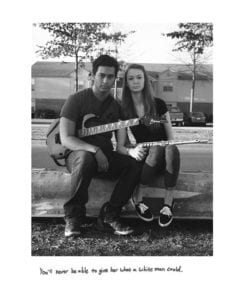

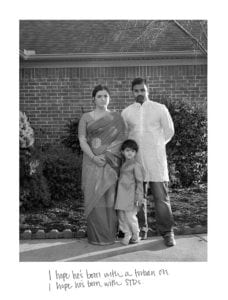
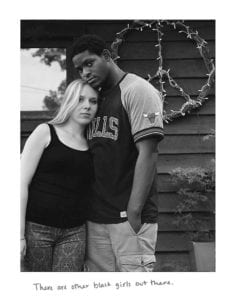
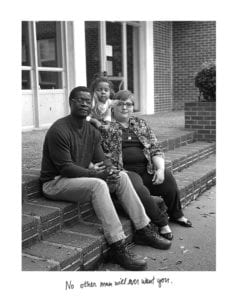
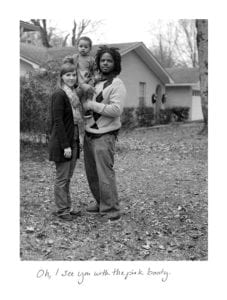
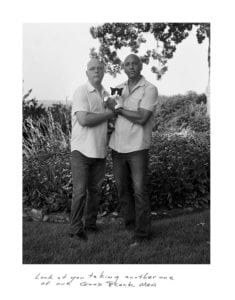

[…] Db Dennis Waltrip interviews Donna Pinckley for SxSE Photomagazine, here. […]
[…] https://www.buildsxsemagazine.com/2016/07/donna-pinckley-talks-db-waltrip/ […]